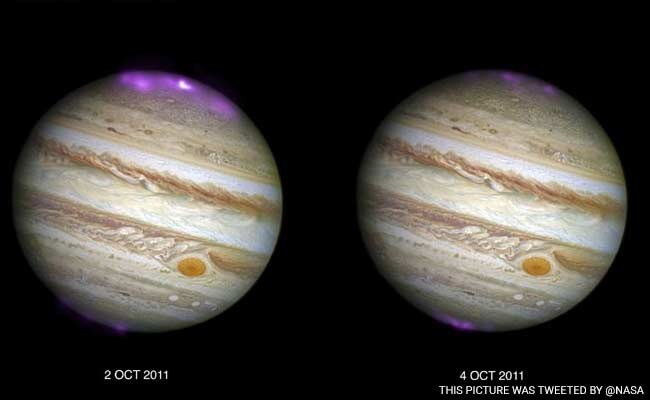
When the solar storm arrived in 2011, we saw that the hot spot pulsed more rapidly, brightening every 26 minutes.
London:
Solar storms trigger Jupiter's intense 'Northern Lights' by generating a new X-ray aurora that is eight times brighter than normal and hundreds of times more energetic than Earth's aurora borealis, a new study has found, using data from NASA's Chandra X-Ray Observatory.
It is the first time that Jupiter's X-ray aurora has been studied when a giant storm from the Sun arrived at the planet, researchers said.
"There's a constant power struggle between the solar wind and Jupiter's magnetosphere. We want to understand this interaction and what effect it has on the planet," said lead author William Dunn, PhD student at University College London.
"By studying how the aurora changes, we can discover more about the region of space controlled by Jupiter's magnetic field, and if or how this is influenced by the Sun," said Mr Dunn.
The Sun constantly ejects streams of particles into space in the solar wind. When giant storms erupt, the winds become much stronger and compress Jupiter's magnetosphere, shifting its boundary with the solar wind two million kilometres through space.
The study found that this interaction at the boundary triggers the high energy X-rays in Jupiter's Northern Lights, which cover an area bigger than the surface of the Earth.
"Comparing new findings from Jupiter with what is already known for Earth will help explain how space weather is driven by the solar wind interacting with Earth's magnetosphere," said Professor Graziella Branduardi-Raymont, from UCL.
The impact of solar storms on Jupiter's aurora was tracked by monitoring the X-rays emitted during two 11 hour observations in October 2011 when an interplanetary coronal mass ejection was predicted to reach the planet from the Sun.
Scientists used the data collected to build a spherical image to pinpoint the source of the X-ray activity and identify areas to investigate further at different time points.
"In 2000, one of the most surprising findings was a bright 'hot spot' of X-rays in the aurora which rotated with the planet. It pulsed with bursts of X-rays every 45 minutes, like a planetary lighthouse," Mr Dunn said.
"When the solar storm arrived in 2011, we saw that the hot spot pulsed more rapidly, brightening every 26 minutes," he said.
"We're not sure what causes this increase in speed but, because it quickens during the storm, we think the pulsations are also connected to the solar wind, as well as the bright new aurora," Mr Dunn said.
The study was published in the Journal of Geophysical Research - Space Physics.
It is the first time that Jupiter's X-ray aurora has been studied when a giant storm from the Sun arrived at the planet, researchers said.
"There's a constant power struggle between the solar wind and Jupiter's magnetosphere. We want to understand this interaction and what effect it has on the planet," said lead author William Dunn, PhD student at University College London.
"By studying how the aurora changes, we can discover more about the region of space controlled by Jupiter's magnetic field, and if or how this is influenced by the Sun," said Mr Dunn.
The Sun constantly ejects streams of particles into space in the solar wind. When giant storms erupt, the winds become much stronger and compress Jupiter's magnetosphere, shifting its boundary with the solar wind two million kilometres through space.
The study found that this interaction at the boundary triggers the high energy X-rays in Jupiter's Northern Lights, which cover an area bigger than the surface of the Earth.
"Comparing new findings from Jupiter with what is already known for Earth will help explain how space weather is driven by the solar wind interacting with Earth's magnetosphere," said Professor Graziella Branduardi-Raymont, from UCL.
The impact of solar storms on Jupiter's aurora was tracked by monitoring the X-rays emitted during two 11 hour observations in October 2011 when an interplanetary coronal mass ejection was predicted to reach the planet from the Sun.
Scientists used the data collected to build a spherical image to pinpoint the source of the X-ray activity and identify areas to investigate further at different time points.
"In 2000, one of the most surprising findings was a bright 'hot spot' of X-rays in the aurora which rotated with the planet. It pulsed with bursts of X-rays every 45 minutes, like a planetary lighthouse," Mr Dunn said.
"When the solar storm arrived in 2011, we saw that the hot spot pulsed more rapidly, brightening every 26 minutes," he said.
"We're not sure what causes this increase in speed but, because it quickens during the storm, we think the pulsations are also connected to the solar wind, as well as the bright new aurora," Mr Dunn said.
The study was published in the Journal of Geophysical Research - Space Physics.
Track Latest News Live on NDTV.com and get news updates from India and around the world

